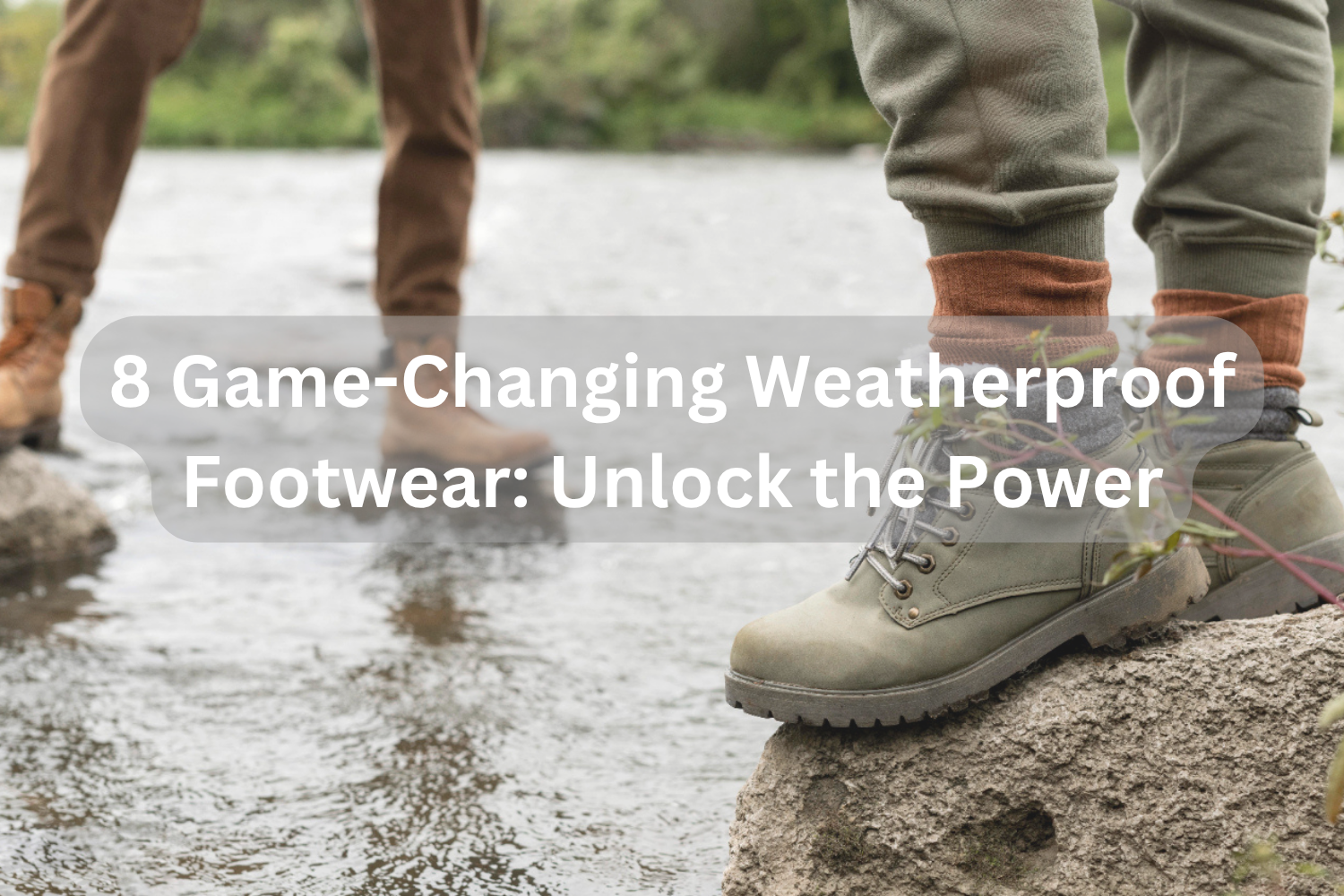Introduction
Whether it’s unpredictable changes in weather, fun with the family or dynamite at midnight, we want to make sure you have the right footwear for any adventure. With protection and style for all seasons, weatherproof footwear has now become a necessity in outdoor gear. Wade through muddy trails, beat the snowy trails, or just enjoy a wet day outside wearing a high quality weatherproof shoe because there’s no way their feet will stay dry and comfortable and well supported underneath you. In this article we’re going deep into eight game changing options that bring the power of weatherproof footwear to the world.
Understanding Weatherproof Footwear
Before detailing the different types of weatherproof footwear, it’s important to know what makes these shoes different. Weatherproof footwear is footwear that utilizes materials, and, in some cases, construction methods, which prevent water, wind, and other harsh weather elements from entering the shoe.’ Not all weatherproof shoes, however, are the same.
- Waterproof vs. Water-Resistant: Waterproof shoes do not allow the slightest hint of water in as you could stand in a puddle and still have dry feet. The second main type of waterproof boots are water resistant. For example, good waterproof boots will have waterproof membranes and sealed seams while water resistant sneakers may be finished with a water repellant coating.
Benefits of Weatherproof Footwear
Investing in weatherproof footwear offers a plethora of benefits that extend beyond just keeping your feet dry.
- Protection from Elements: Your feet can be decimated by rain, snow, mud, wind, and everything in between. Weatherproof shoes create a barrier within your shoes, keeping water out, and keeping your feet warm and dry. This kind of protection can help you avoid poor wearing comfort and health problems, such as blisters or frostbite.
- Increased Durability and Longevity: Regular shoes are usually made from more durable materials then weatherproof footwear. They live in harsher yet have the endurance to live longer which save you money in the long run.
- Year-Round Versatility: Weatherproof footwear, whether that be rain in summer or snow in winter, can be an asset to be kept in the closet. The designs convert perfectly to many activities from hiking to casual outings.
Key Features to Look for in Weatherproof Footwear
When choosing weatherproof footwear, consider the following key features:
- Material Quality and Construction: Look for shoes made from high-quality materials, such as full-grain leather or synthetic fabrics designed to resist water. Features like reinforced stitching and rubber soles can enhance durability.
- Tread and Sole Grip: The sole of your shoe should have a strong tread pattern that provides traction. This is particularly important in slippery conditions where good grip can prevent falls.
- Insulation and Breathability: Depending on your climate, you may want footwear that offers insulation for warmth, especially in snowy environments. However, shoes should also allow for breathability to prevent moisture buildup inside.
Types of Weatherproof Footwear for Different Conditions
Different activities and weather conditions call for specific types of footwear. Here’s a breakdown:
- Boots for Heavy Rain and Snow: Look for tall, waterproof boots with insulated linings. These are essential for trudging through snow and puddles.
- Hiking Shoes for Wet and Muddy Trails: Hiking shoes with waterproof membranes are perfect for those who enjoy outdoor activities. They keep your feet dry while providing support on uneven terrains.
- Everyday Sneakers with Weather-Resistant Features: Casual sneakers now come with weather-resistant treatments that repel light rain, making them suitable for everyday wear.
- Sandals with Water-Ready Design: Ideal for summer adventures, these sandals are made from materials that dry quickly and often feature non-slip soles for safety on wet surfaces.
Top 8 Game-Changing Weatherproof Footwear Options
Option 1: Heavy-Duty Rain Boots
If you live in a rainy climate then you will need heavy duty rain boots. These boots are made from waterproof rubber, and have a tall shaft and the ability to be cleaned easily. Search for styles with cushioned insoles for extra comfort over extended periods of wear.
Option 2: Insulated Snow Boots
Insulated snow boots are designed to keep your feet warm and dry in harsh winter conditions, with thick linings, and waterproof external construction. If you’re in the market for some new boots, luckily, these can be stylish and functional all at once, like the boots offered by brands like Sorel and Columbia.
Option 3: Hiking Shoes with Waterproof Membranes
For those who love exploring nature, waterproof hiking shoes equipped with breathable membranes (like GORE-TEX) are a game-changer. They keep your feet dry while allowing moisture to escape, which is essential for comfort on long hikes.
Option 4: All-Weather Sneakers
These versatile sneakers combine style and practicality, featuring weather-resistant materials that repel water. Brands like Nike and Adidas offer models designed for everyday wear, ensuring you stay comfortable regardless of the weather.
Option 5: Lightweight Water-Resistant Running Shoes
If you love running, then lightweight water resistant shoes keep you adaptable to sporty action during worse weather. Popular brands such as Brooks and Asics offer a number of models that have water repellent coating for which your feet don’t get wet but provides excellent cushioning and support.
Option 6: Waterproof Sandals
Waterproof sandals are perfect for beach trips or river adventures. These sandals often feature quick-drying materials and adjustable straps for a secure fit, making them ideal for wet conditions.
Option 7: Multi-Purpose Trail Shoes
Multi-purpose trail shoes are designed to handle a variety of terrains and conditions. They typically feature waterproof uppers, rugged outsoles, and good cushioning, making them suitable for hiking and casual wear.
Option 8: Weatherproof Work Boots
Outdoor work boots are weatherproof for those who work outdoors. They protect your feet from water and debris and support your feet and keep your feet comfortable during long hours on your feet. Safety also determines the kind of shoes you want. Several features to look out for include steel toes and slip resistant soles.
How to Choose the Right Weatherproof Footwear
Selecting the right weatherproof footwear involves assessing your specific needs based on climate and planned activities:
- Assessing Your Needs: Think about the activities you perform in your job that create value for your customers. If you will hike amid wet conditions, it’s much better to prefer waterproof hiking boots. In rainy weather, go for stylish, water resistant sneakers that can work for your urban commute.
- Finding the Right Fit: They need to be properly fitted to be comfy. Be sure to try on shoes when you’ll be wearing the socks you wear (or plan to wear), and walk around a bit to ensure there are no pressure points or discomfort.
- Balancing Style with Functionality: Functionality is important, but you don’t have to compromise style. Currently, many brands also have stylish, weatherproof options that don’t sacrifice sleeve performance.
How to Care for Your Weatherproof Footwear
Proper care extends the life of your weatherproof footwear:
- Cleaning Techniques: Different materials require different cleaning methods. Use a soft brush or cloth for leather and a damp cloth for synthetic materials. Always refer to the manufacturer’s instructions.
- Proper Drying and Storage: Avoid placing shoes near direct heat sources, as this can damage the materials. Instead, air dry them in a well-ventilated area. Store your footwear in a cool, dry place to prevent mold and mildew.
- Reapplying Waterproof Treatments: Over time, waterproofing treatments can wear off. Regularly reapply treatments designed for your specific footwear material to maintain their effectiveness.
Common Mistakes to Avoid with Weatherproof Footwear
To get the most out of your weatherproof footwear, avoid these common mistakes:
- Ignoring Proper Care Routines: Neglecting to clean and care for your shoes can lead to premature wear. Make it a habit to clean them after each use, especially if they’ve been exposed to mud or salt.
- Using Footwear in Conditions It’s Not Designed For: Always use footwear for its intended purpose. Wearing lightweight sneakers in deep snow can lead to cold, wet feet, while using heavy boots for casual wear can cause discomfort.
- Choosing Style Over Functionality: While it’s tempting to opt for the trendiest styles, prioritize functionality to ensure your footwear serves its purpose. There are plenty of stylish options that also offer great protection.
Top Brands Known for Weatherproof Footwear
When shopping for weatherproof footwear, consider these reputable brands:
- Merrell: Known for their durable hiking shoes and boots that excel in various weather conditions, Merrell offers options with superior grip and waterproofing.
- Columbia: This brand produces a wide range of weatherproof footwear suitable for everything from everyday wear to intense outdoor adventures.
- Hunter: Famous for their stylish rain boots, Hunter offers fashionable yet functional options that are perfect for wet conditions.
Conclusion
With the weather changing so fast these days, you need the right footwear. Apart from comfort and protection, weatherproof footwear adds a boost to your all in all outdoor experience. Whether you’re looking for heavy duty rain boots or stylish waterproof sneakers, there is the perfect pair for everyone. If you know your needs and wisely select, you can make the most out of whatever adventure you decide to bring your hammock to, rain or shine.
Frequently Asked Questions
Q: Can I use weatherproof footwear in all conditions?
A: Not all weatherproof footwear is suitable for every condition. Always choose footwear designed for specific weather types, like snow or rain.
Q: How long does weatherproof footwear last?
A: The lifespan of weatherproof footwear varies based on usage and care but typically lasts several seasons with proper maintenance.
Q: Do weatherproof shoes sacrifice breathability?
A: Many modern weatherproof shoes are designed with breathable materials, allowing for airflow while still keeping water out.
Q: Are waterproof and weatherproof the same?
A: While often used interchangeably, “waterproof” means impervious to water, whereas “weatherproof” suggests protection against various elements, including water.
Q: How can I tell if my shoes need waterproofing again?
A: If your shoes start to absorb water during light rain or feel damp inside after use, it’s time to reapply waterproof treatments.





